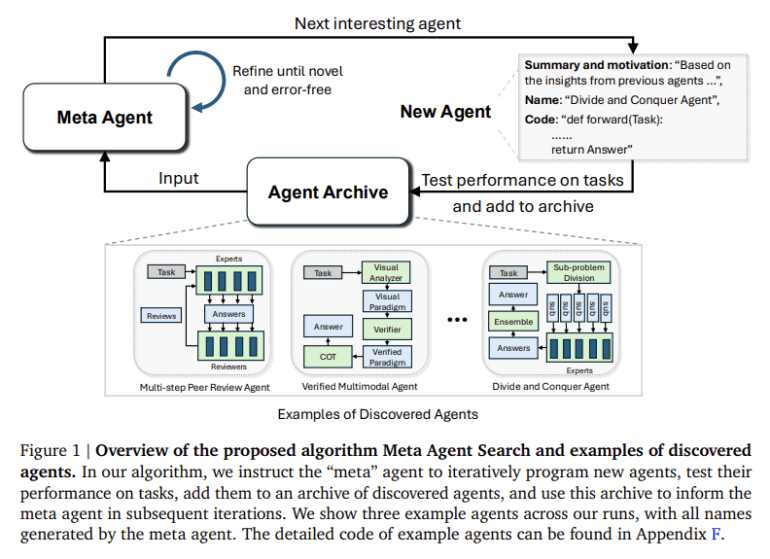- Automated design in AI is emerging as a key innovation, enabling systems to generate and optimize their components independently.
- The approach leverages machine learning to surpass the limitations of manual design, creating more efficient, adaptable, and robust AI systems.
- Significant manual effort in traditional AI development is becoming a bottleneck as AI tackles more complex tasks, highlighting the need for automation.
- Researchers have developed the Automated Design of Agentic Systems (ADAS), which automates the entire AI design process using a meta-agent that codes new agents.
- ADAS explores vast system configurations, discovering superior AI architectures without manual intervention.
- The ADAS method has significantly improved task performance, demonstrating its potential to outperform manually designed AI systems.
- ADAS’s robustness and adaptability across domains and models make it a transformative force in AI development.
Main AI News:
In the fast-paced world of artificial intelligence, automated design is gaining traction as a game-changer. This approach aims to create systems that autonomously generate and refine their components. By harnessing the capabilities of machine learning, this approach seeks to transcend the limitations of traditional design processes, paving the way for AI systems that are more efficient, adaptable, and powerful. The objective is to equip these systems with the ability to innovate and solve increasingly complex challenges, particularly in environments that require dynamic and flexible problem-solving strategies.
One of the most significant hurdles in AI development today is the substantial manual labor needed to design, configure, and optimize these systems for specific applications. As AI is increasingly applied to more sophisticated and diverse tasks, the demand for systems operating autonomously, with minimal human intervention, is becoming critical. This challenge concerns the time and expertise required and the inherent constraints of human-designed solutions. There is a growing acknowledgment that automating the design process could uncover novel and superior AI architectures that may be overlooked through conventional, human-driven methods.
Historically, AI systems have relied heavily on manual design approaches, where experts painstakingly develop and integrate specific components, such as prompts, control flows, and tools tailored to particular tasks. While these methods have proven successful, they are inherently limited by the necessity for deep human expertise and the time-consuming nature of the design process. Recent advances in areas like automated machine learning (AutoML) and AI-generating algorithms (AI-GAs) have started to reduce these constraints by introducing automation into the system design process. However, these methods often have a narrow focus, targeting specific components rather than the entire system architecture.
Enter the Automated Design of Agentic Systems (ADAS), a revolutionary approach developed by researchers at the University of British Columbia, the Vector Institute, and the Canada CIFAR AI Chair. This cutting-edge method aims to fully automate AI system design using a meta-agent that codes new agents. What sets the ADAS approach apart is its ability to explore a vast range of potential system configurations, enabling the discovery of more effective and efficient AI architectures without manual input. The meta-agent works iteratively, creating, evaluating, and refining agentic systems, building on an ever-growing archive of previous designs to drive further innovation.
The results from the ADAS approach are nothing short of remarkable. For instance, agents discovered by the ADAS algorithm have boosted F1 scores in reading comprehension tasks by 13.6 points and increased accuracy rates in math tasks by 14.4%. These agents also displayed impressive adaptability, achieving accuracy improvements of 25.9% and 13.2% in math tasks when transferred across different domains. Moreover, the high performance of ADAS-discovered agents was maintained even when applied to other models, such as GPT-4 and Claude-Sonnet, where they consistently outperformed their manually designed counterparts. This robustness highlights the transformative potential of ADAS in AI system design and implementation.
Conclusion:
Introducing Automated Design of Agentic Systems (ADAS) signals a major shift in the AI market. As ADAS reduces the need for manual design, it accelerates the development process, enabling companies to innovate more rapidly and efficiently. This factor has profound implications for the competitive landscape, as businesses leveraging ADAS can develop superior AI systems with less resource expenditure, potentially disrupting traditional AI development models. The ability of ADAS to generate adaptable and high-performing AI across various domains further enhances its value, positioning it as a critical tool for companies aiming to stay ahead in the rapidly evolving AI industry.

